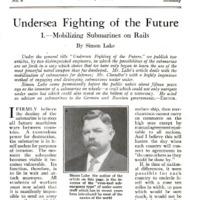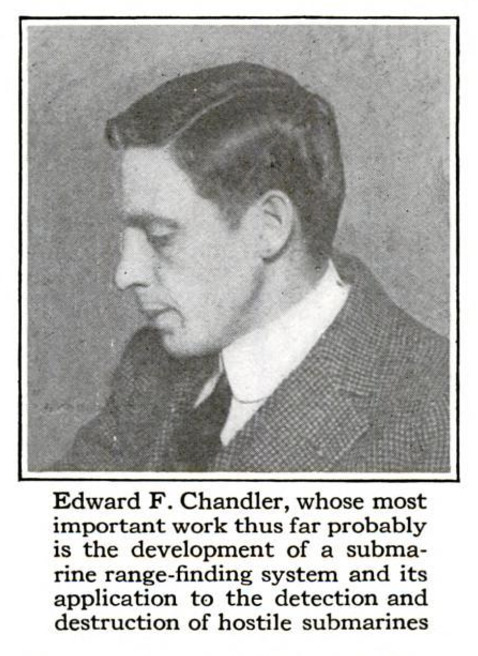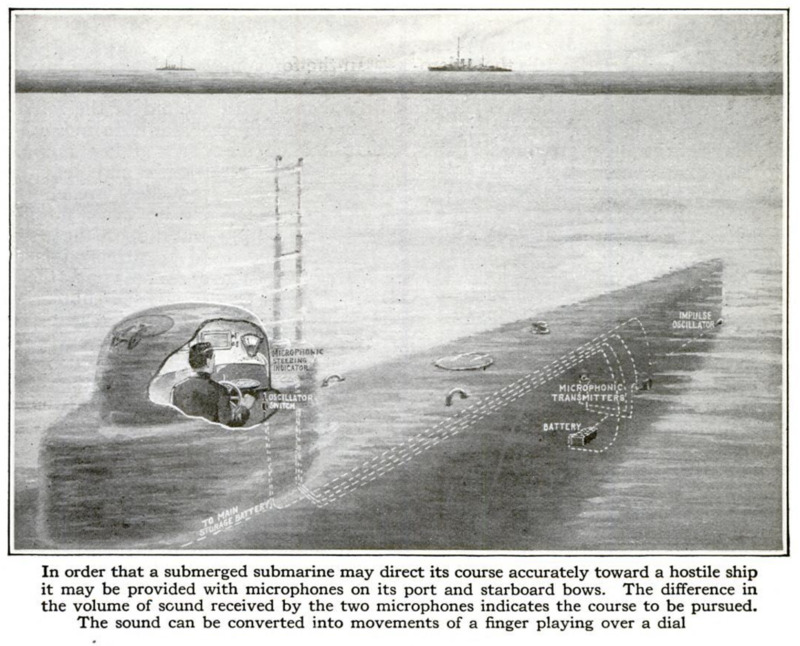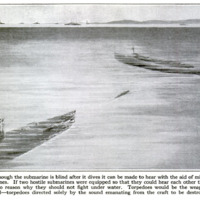-
Title (Dublin Core)
-
Undersea Fighting of the Future. II.-Battling with Telephones
-
Article Title and/or Image Caption (Dublin Core)
-
Undersea Fighting of the Future. II.-Battling with Telephones
-
extracted text (Extract Text)
-
IF the war has taught us anything it
has taught us that the submarine
must be reckoned with both as an |
annihilator of battleships and as a de-
stroyer of commerce. Of the dozens of |
instrumentalities
invented for killing on
a wholesale scale it is
the most terrible. And
yet how crude is_this
new weapon! Com-
pared with what it can
be made it is what the
blunderbuss of old is
to the modern rifle.
Consider for a mo-
ment how a submarine
boat is handled. The
commander plows
along at the surface
much as he would on
any ship. In the offing
he” sees a pillar of
smoke. Friend or foe?
He: must investigate.
Changing his course,
he steers for that
cloud on the horizon. In fifteen minutes
he has approached near enough to dis-
cover that the smoke is pouring from the
funnels of a hostile collier. She flies the
naval ensign of her country, and she is
convoyed by a torpedo-boat destroyer.
Thesubmarine commander givesan order.
Water surges into tanks in the subma-
rine’s hold. The craft sinks until only
her periscope projects from the water.
Heading for the collier the submarine
arrives within half a mile of its prey.
The commander takes the bearings of
the collier by compass and orders com-
plete submergence. In another minute
the craft is completely under the surface.
A sharp command, and a puff of com-
pressed air starts a torpedo from one
of the launching-tubes. In less than
a minute it has reached the collier. There
is a dull explosion. Fifteen minutes later
a cargo of four thousand tons of coal lies
at the bottom of the sea. and a hundred
brave men have per-
ished miserably.
Why the Submarine
Is Crude
It seems very simple,
very certain, this tor-
pedoing of a ship from
a safe place under the
water. But for all that
it is unscientific and
haphazard. The sub-
marinecommander sees
nothing below the sur-
face ; that is why he
must take aim before he
submerges. To strike,
the target must be large
and very near ; other-
wise he would surely
miss. Suppose that you
were told to shoot
blindfolded at a mark one hundred yards
away and that you were given two
minutes to locate the target before your
eyes were covered. You would be exactly
in the position of a submarine com-
mander about to torpedo a hostile
ship. Is it any wonder that torpedoes
must be fired at close range? Is it not
obvious that the submarine could be
made still more terrible if the submarine
commander could locate his quarry
accurately in the inky blackness in
which he is immersed?
To use lights under water is hopeless.
Even millions of candlepower would not
reveal the presence of a ship a mile off
to a submerged underwater craft. But
suppose that the commander of a sub-
marine could locate his prey by sound;
suppose that he could hear a ship and
locate her by sound more accurately, for
example, than a blind man can locate the
position of a ticking clock in a room?
Might not that solve the problem?
With this thought in mind, I have
worked out a method of utilizing micro-
phones—a method which is a modifica-
tion and extension of that which I
described in the POPULAR SCIENCE
MonTHLY for October, 1915. Those
who read that article will remember
that I showed how it was possible to
make a torpedo guide itself toward the
beating propellers of a ship with the aid
of microphones—*electrical ears,” as T
call them. A microphone is found in
every telephone transmitter. It is an
instrument for intensifying feeble sounds,
or for transmitting sounds, and it is
based on the principle that the transi-
tion between loosely joined electric con-
ductors decreases in proportion as they
are pressed together. The conductors
form part of a circuit through which a
current is passing, and the variations in
pressure due to sound waves in the
vicinity of the conductors produce
variations of resistance, and hence
fluctuations of the current, so that the
sounds are reproduced in a telephone
receiver. Inthe modern telephone the
transmitter is essentially a microphone,
the pressure of the sound waves being
communicated to the conductors by
means of a diaphragm.
In a torpedo of the type I described in
the POPULAR SCIENCE MONTHLY, the
microphones are mounted in pairs on
both sides of the nose. So long as the
sound of the hostile ship's beating pro-
pellers, traveling through water far more
readily than sounds travel through. air,
affect’ all microphones with equal
intensity, the torpedo rushes on straight
to its mark. But if the vessel should
change its course, the vibrations of the
propellers would no longer strike the
two pairs of microphones with equal
force; one pair would be more affected
than the other—the pair directly ex-
posed to the vibrations. At once
electrical circuits are closed and auto-
matic mechanism started which swings
the rudders of the torpedo and points
the nose of the torpedo toward its mark.
As soon as the microphones on both sides
are restored to electrical equilibrium, in
other words as soon as they hear with
equal clearness, the torpedo keeps on a
straightaway course.
It is evident that the same principle
can be applied to submarine boats travel-
ing under water, with the difference that
since the submarine is manned by intel-
ligent human beings, the microphones
can be made merely to indicate the
course to be pursued, leaving to the
commander the task of steering a true
course. As in the case of the sound-
controlled torpedo, the submarine is
provided with microphones on its port
and starboard bows. Telephone ear-
pieces are provided which enable the sub-
marine commander to listen to the
sounds gathered by the microphones.
If the submarine is not pointed head on
toward the ship to be destroyed the
microphone on the off side will hear less
than the other, and the difference in the
volume of sound received by the two
microphone detectors will be noted at
once in the telephone receivers. The
commander changes his course until he
hears equally well with both ear-pieces.
Seeing Sounds on a Dial
While it is perfectly feasible to direct
a submarine by telephone it is much
more effective to convert the microphone
vibrations into visual signals. As a
result the commander of a submarine
has only to watch a finger move over a
dial in order to know what course he
should steer. In a sense he sees the
sound which the microphone detectors
hear. The accompanying diagram sets
forth the essential principles of this
conversion of the microphone vibrations
into visual signals so clearly that an
extended description seems hardly neces-
sary.
While a visual steering indicator is
primarily depended upon to guide the
submarine on its deadly errand, tele-
phones are connected with the micro-
phones, to be used when the occasion
arises. With their aid the commander
learns a new language. He realizes the
meaning of strange grindings, hums,
moans, blows, mur-
murs and vibrations
—the many tongues
of the sea. If we but
knew it the water of
the ocean is a veri-
table Babel; it is a
great reservoir of
sound, the recipient
of ten thousand differ-
ent vibrations, rang-
ing from the grinding
of pebbles to the
pounding of steam-
ship engines. Justasa
woodsman learns the
meaning of the weird
soughing of wind in
tree tops, the “woof”
of a bear, the patter
of deer’s feet and the
cll of quail, so a
submarine comman-
der can distinguish
one underwater sound
from another and in-
terpret it correctly.
A tramp steamer can
be microphonically
distinguished from a
Mauretania, a tor-
pedo-boat from a
superdreadnought,
and above all a sub-
surface craft from a
surface craft. Thus
the character of an
unseen ship miles away can be ascer-
tained.
But apart from listening to passing
ships, che telephones will be required to
receive messages from an admiral on a
battleship five miles away. Both war-
ships and merchantmen are equipped
with submarine signaling devices —
devices which send forth either bell
sounds or rhythmic vibrations. It is
easy to see how useful they can be made
to telegraph orders to a submarine under
water five miles or more away.
Under Water Echoes and How They
Are Applied
In the foregoing account of my inven-
tion I have assumed that the vessel to
be attacked with the aid of the micro-
phonic steering-indicator is in motion— |
that its engines are giving audible
sounds and that its
propellers are churn-
ing up water noisily.
But suppose the vessel
to be attacked is at
anchor—what then?
Is not the submarine
commander helpless?
The difficulty is
easily overcome if we
can make the sub-
marine produce a
characteristic sound
and if we can have
that sound echoed
back from the ship to
be sunk and picked
up by the submarine's
own microphones.
Fortunately Professor
Fessenden has pro-
vided an instrument
ideally suited for the
purpose. Called an
oscillator, it may be
regarded as a kind of
underwater klaxon
horn, the diaphragm
of which is electrically
vibrated to emit a
characteristic bleat.
By means of a switch,
located near the hand
of the submarine com-
mander, the oscillator
can be turned on or
off.
~ Theoscillator will be of use not only to
locate a ship at rest but to save the
submarine in a nerve-racking emergency.
Imagine the commander of a U-boat
bent on the destruction of a ship enter-
ing a harbor and traveling along at the
surface with only his periscope exposed.
A fast armed motorboat looms up—a
type of craft which has proved to be
a most formidable enemy. The sub-
‘marine must act quickly. There is but
one course—to sink quickly. Valves are
opened and tanks filled. The craft
sinks out of sight. It is safe for the
moment. The agonizing uncertainty of
the crew can be imagined. They know
that a relentless enemy awaits them, that
his searchlights sweep the water all
night. Hour after hour drifts by. If
the submarine’s commander rises, a hail
of shot and shell is sure to rain upon
him; if he stays under water very long
he and his men will die of suffocation.
Why not move on? The waiting motor-
boat cannot see him. But in what
direction and how far? He is almost
sure to run into the shore and to puncture
the thin shell that saves him from
inundation. If he could only locate the
harbor entrance he would be safe. An
oscillator and a set of microphones will
enable him to head for the inlet as surely
as if he were traveling on the surface
and he could see it with his eyes. He
pulls the switch of the oscillator. A
shrill note is sent through the water.
His eyes on the steering indicator dial,
he watches the response of the finger
to an echo. The echo of what? Of the
oscillator’s vibrations reflected by the
shore. He steers this way, now that way,
barely crawling along, always watching
for the echo on the dial. The finger on
the steering indicator moves from side
to side as the microphones pick up the
echoes. At last there comes a moment
when the finger stays at zero, when, in
other words, there is no echo for the
microphones to hear. That
can mean only one thing: the
oscillator is sending out its
bleat not toward an echoing
shore, but toward the har-
bor's mouth and toward the
open sea, where safety lies.
PE and on the verog
indicator the commander sig
nals “full speed ahead,” know-
ing that salvation lies before
him.
Artificial Senses Take the
Place of Eyes and Ears
The use of microphones on
submarines not only increases
the effectiveness of the sub-
‘marine enormously, but opens
up new and intensely dramat-
ic possibilities. As soon as
one submarine is equipped
with devices for threading a course
underwater with certainty all submarines
will be similarly equipped. Grant that
and at once we have the means of
pitting submarine against submarine, of
actually engaging in submarine fights.
‘What strange encounters they will be—
these underwater engagements of the
future! Two vessels, blind but for
steering indicators connected with micro-
phones, circling around each other in the
effort to ram or to plant a torpedo at the
right moment, cocking electrical ears, as
it were, and mancuvering entirely by
sound—what battle of Wells or of
Verne's can compare with it? Instru-
ments, artificial senses, take the place
of Nature's eyes and ears; hidden move-
ments are electrically translated into
twitches of a quivering finger on a
graduated dial; one intelligence is pitted
against another. Surely this is real
scientific warfare—this battle of micro-
phones!
A Sewer Banquet at $25 a Plate
TC celebrate the completion of a new
sewer in St. Louis a cabaret banquet
was held in the tube. A “banquet room"
three hundred feet long and a gas-
equipped kitchen were created. The
food was cooked in the tunnel and served
on_ twelve tables placed lengthwise.
The cost of the banquet was twenty-
five dollars a plate.
-
Contributor (Dublin Core)
-
Edward F. Chandler (inventor and writer)
-
Language (Dublin Core)
-
eng
-
Date Issued (Dublin Core)
-
1916-06
-
pages (Bibliographic Ontology)
-
805-809
-
Rights (Dublin Core)
-
Public Domain (Google digitized)
-
Archived by (Dublin Core)
-
Filippo Valle
-
Alberto Bordignon (Supervisor)
 Popular Science Monthly, v. 88, n. 6, 1916
Popular Science Monthly, v. 88, n. 6, 1916









